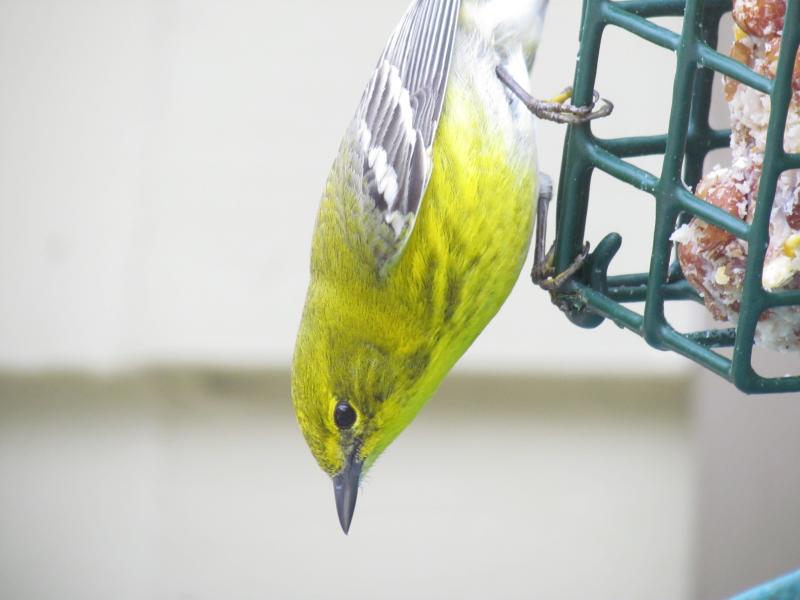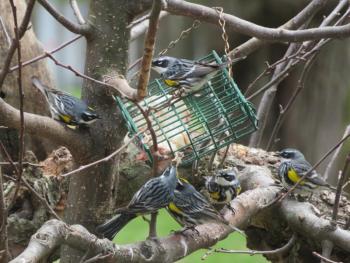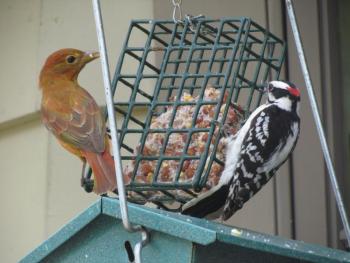A sea of migrating birds is flowing into and over our state right now. That’s what happens every spring as the billions of birds that winter in the southern U.S., Mexico, the Caribbean, and Central and South America make their way back north to their breeding grounds. That’s what we celebrate each year on International Migratory Bird Day—this year on Saturday, May 11.
But sometimes those returning birds find conditions along the migratory route that are not so nice.
That’s what happened to the warblers and other songbirds that found themselves here in Maine over the past week or two when we seemed caught in an endless loop of cold, rainy weather. We were very aware of it because our son’s high school tennis matches were either repeatedly canceled or, when they took place, found us wishing we had worn winter coats and long johns just to sit in and watch the matches.
Backyard bird feeding enthusiasts took notice of the conditions and what they meant for birds when species not normally seen at feeders began to appear. Birders from around the state began reporting and sending photos, especially of the birds at their suet feeders. Normally the birds that feed on suet are fairly limited—woodpeckers especially, but also chickadees and nuthatches are the norm.
Not in this cold, rainy late April and early May. Instead, dozens of people were finding yellow breasted pine warblers and bright bluish backed yellow-rumped warblers picking away at the suet. One birder from Bowdoinham sent photos showing a flock(!) of yellow-rumped warblers at her suet feeder. We had several yellow-rumps at ours and our next-door neighbor’s as well.
Some lucky and observant people had some rare birds show up to feed on their suet. Someone from Lincolnville had a yellow-thoated warbler, a species normally found only as far north as southern New Jersey. We got an email from some friends in East Boothbay with a photo of a bird that they did not recognize coming to the feeders and bird bath on their porch. The photo showed the bird to be a rare summer tanager—like the yellow-throated warbler, a bird of the southeastern U.S. that breeds only as far north as southern New Jersey. We had seen summer tanagers only weeks before when we were on vacation in Florida.
The next day we were at our friends’ home in East Boothbay, hoping for at least a glimpse of this off-track wander. We settled in to a comfortable bench on the porch overlooking the ocean through the trees, and as we chatted with our friends, a pine warbler came in and tamely pecked chunks of suet from the feeder just a few feet away. Juncos hopped almost at our feet, and a steady procession of chickadees and titmice came and went.
And then suddenly, there was the summer tanager. It was a little shy at first, more so than the other birds, although it had apparently been very tame around our friends. The bird watched us from some tree branches near the porch and then to the roof. From there, it hopped onto the suet, giving us beautiful views. It was a young male, so instead of being entirely bright red, it was more of an orangey-red color but gorgeous nonetheless. It even let out a few of its characteristic “pi-tucky-tuk” call that is so different from Maine’s own scarlet tanager’s “chip-burr” call.
We were happy to see that the summer tanager was also catching insects in nearby trees in between its visits to the feeders on that day—one of the first warm days we’d had in the last few weeks. That food and the warm winds may have sent the bird on its way, as our friend reported that it was no longer being seen the day after our visit.
We hope you all can find time to celebrate the return of our migrating birds and International Migratory Bird Day this weekend!
Jeffrey V. Wells, Ph.D., is a Fellow of the Cornell Lab of Ornithology. Dr. Wells is one of the nation's leading bird experts and conservation biologists and author of “Birder’s Conservation Handbook”. His grandfather, the late John Chase, was a columnist for the Boothbay Register for many years. Allison Childs Wells, formerly of the Cornell Lab of Ornithology, is a senior director at the Natural Resources Council of Maine, a nonprofit membership organization working statewide to protect the nature of Maine. Both are widely published natural history writers and are the authors of the book, “Maine’s Favorite Birds” and “Birds of Aruba, Bonaire, and Curaçao: A Site and Field Guide” from Cornell Press.





























